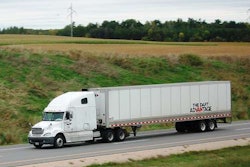Volvo Trucks on Monday, June 27, announced that its New River Valley manufacturing plant in Dublin, Va., reduced its energy intensity by nearly 30 percent in just one year, making it the first company to meet a 10-year challenge set by the U.S. Department of Energy.
DOE launched the Save Energy Now Leader Program in October 2009 as a challenge to the U.S. industrial sector. Volvo Trucks in North America and 31 other major companies pledged to reduce their intensity of energy per unit of production by 25 percent over a decade.
“Volvo met the Save Energy Now target in one year instead of 10,” says Chief Operating Officer Patrick Collignon, who served as vice president and general manager of the NRV plant during the time in which the target was met. “This accomplishment exemplifies our commitment to our core value of environmental care. Thanks to the engagement of employees across the organization, we’re lowering energy use while at the same time operating more efficiently.”
The plant reduced its MMbtu per truck (the DOE metric for energy intensity) from 79.64 in 2009 to 60.42 in 2010 – a reduction of 29.6 percent. “Just as important as the DOE metric is our significant reduction in total energy use at the plant,” Collignon says. “We reduced our total electricity consumption by 28 percent and natural gas consumption by 35 percent since the energy team was started.”
Every Volvo truck sold in North America is assembled in the United States at the NRV plant. Volvo Trucks says that since introducing No Regen SCR aftertreatment technology to meet current U.S. Environmental Protection Agency standards, it has improved the fuel efficiency of its trucks by up to 8 percent or more, with near-zero regulated emissions.
According to the company, customer response to these trucks, fully certified to the EPA 2010 emissions standards, has been extremely positive, driving an increase in demand. “Volvo is delivering the cleanest trucks in the world, we’re making them in the U.S., and we’re doing it in a way that shrinks our carbon footprint,” says Ron Huibers, senior vice president – sales and marketing.
To reach the aggressive energy reduction goals, Volvo Trucks took advantage of DOE assessments, established a dedicated energy team at the NRV plant and worked to make energy savings part of the employee mindset. A detailed energy map was developed, clarifying where and how energy was being used.
Team members agreed to pursue many small energy-saving tactics and also to attack the biggest energy-consuming process: the paint operation. “To use a financial analogy, it’s not always easy to come up with an idea that saves $1,000, but it is usually possible to come up with 1,000 ideas that save one dollar each,” says Collignon. “In our case, we did both.”
The energy team worked closely with paint shop employees to find ways to make energy-intensive processes more efficient, including optimizing stop and start times. Other companywide efforts include the use of a building automation system to control building temperatures and turn off lighting, a passive solar wall and photovoltaic solar panels. Skylights, new light fixtures (including LED), infrared heaters and solar water heaters were installed.
As cost savings were found, those funds were reinvested in other energy reduction strategies. The New River Valley plant’s improvements haven’t gone unnoticed by customers, who often visit Volvo to see production firsthand, learn about innovations and test-drive trucks.
“First, customers want to know about the trucks, and then the conversation turns to plant operations,” says Huibers. “Many customers ask about energy use and efficiency, and go back to their own businesses with new ideas for reducing energy costs.”
Volvo Trucks says its energy team already has identified a number of additional opportunities for improvement and expects a further 10 to 20 percent reduction in energy intensity this year. The plant also is pursuing ISO50001 certification and working to become carbon neutral within two years.
“Energy reduction is becoming a permanent part of our culture and operations,” says Collignon. “All of us at Volvo Trucks commend the Department of Energy for creating the Save Energy Now Leaders Program. It’s provided us with additional tools, a new group of colleagues across industries and the extra boost we needed to tackle this issue head-on.”













